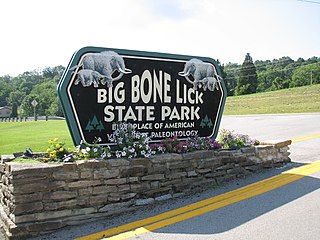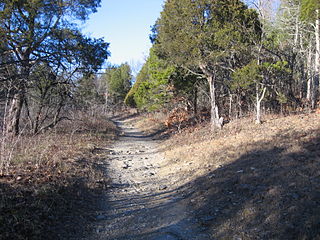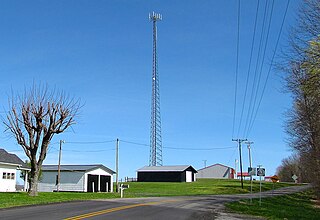
Big Bone Lick State Park is located at Big Bone in Boone County, Kentucky. The name of the park comes from the Pleistocene megafauna fossils found there. Mammoths are believed to have been drawn to this location by a salt lick deposited around sulphur springs. Other animals including forms of bison, caribou, deer, elk, horse, mastodon, moose, musk ox, peccary, sloth, and possibly tapir also grazed the vegetation and salty earth around the springs that the animals relied on for their diet. The area near the springs was very soft and marshy causing many animals to become stuck with no way to escape. It bills itself as "the birthplace of American paleontology", a term which dates from the 1807 expedition by William Clark undertaken at the direction of President Thomas Jefferson. In Nicholas Cresswell's journal, dated 1774 to 1777, he records a visit in 1775 to what was then called "Elephant Bone Lick." In this account, Cresswell describes finding several bones of "prodigious size", as well as tusk fragments, and teeth—one weighing approximately 10 pounds. While he assumed the bones were from ancient elephants, the local native traditions claimed the bones to be those of white buffaloes that had been poisoned by the salty water.

Mouthcard is a small unincorporated community in Pike County, Kentucky, United States near the Virginia state line. It lies on the Levisa Fork River of the Big Sandy River in the heart of the Appalachians. U.S. Route 460 runs through Mouthcard to meet U.S. Route 23 in Pikeville, the county seat.

Blue Licks Battlefield State Resort Park is a park located near Mount Olivet, Kentucky in Robertson and Nicholas counties. The park encompasses 148 acres (60 ha) and features a monument commemorating the August 19, 1782 Battle of Blue Licks. The battle was regarded as the final battle of the American Revolutionary War.
Kentucky Route 39 is a state highway in the U.S. state of Kentucky. The route, part of the State Secondary System, exists in two segments, separated at the Madison-Jessamine county line by the Kentucky River. While there is a boat ramp on each side, there is no bridge or ferry carrying vehicular traffic across the waterway. The southernmost terminus of the route is at Kentucky Route 1247 in Somerset. The northernmost terminus is at U.S. Route 27 Business and Kentucky Route 29 in Nicholasville.
Mann's Lick was a salt lick just north of the present-day Fairdale neighborhood of Louisville, Kentucky. It was named for John Mann, who belonged to a surveying party of Captain Thomas Bullitt in 1773.
Kentucky Route 338 (KY 338) is a 32.228-mile-long (51.866 km) state highway in Kentucky. It begins at KY 20 in Northern Boone County. It goes though Burlington, Kentucky where it intersects with KY 18. It then goes to a small town called Rabbit Hash, Kentucky where it intersects with KY 536 and again with KY 18. After it leaves Rabbit Hash, it runs by Big Bone Lick State Park before intersecting with U.S. Route 42 and US 127 near Union. It turns left onto US 42 and US 127, and then leaves the concurrency about mile north. KY 338 then travels to Richwood, where it has access to Interstate 75 (I-75) and I-71 it ends about 1/4 mile east of the interstate at US 25.

Mud Lick is a rural unincorporated community in Monroe County, Kentucky, United States. It is concentrated around the intersection of Kentucky Route 63 and Kentucky Route 870, northwest of Tompkinsville.

Paleontology in Kentucky refers to paleontological research occurring within or conducted by people from the U.S. state of Kentucky. Kentucky's abundance of exposed sedimentary rock makes it an ideal source of fossils. The oldest exposed rocks in Kentucky are of Ordovician age. The geologic column of Kentucky also contains rocks deposited during the ensuing periods until the end of the Pennsylvanian. During this span of time the state was first home to a warm shallow sea home to an abundance and variety of brachiopods, cephalopods, crinoids, and trilobites. During the Devonian, a large reef system formed at what is now the Falls of the Ohio. Swamps covered Kentucky during the ensuing Carboniferous period. Then a gap spans from the start of the Permian to the Pleistocene, although the gap is interrupted by minor deposits of Cretaceous and Eocene rocks. These deposits mainly preserve plant fossils. Ice Age Kentucky was home to short-faced bear, bison, elk, lions, mammoths, mastodons, and giant ground sloths. Local Native Americans interpreted fossils of this age at Big Bone Lick as belonging to ancient monsters killed by benevolent mystical little people. This same fossil deposit would attract attention from major American figures like George Washington, Daniel Boone, and, especially, Thomas Jefferson. Amateur fossil collectors should be aware that they need permission from landowners to prospect legally on private property. Brachiopods are the Kentucky state fossil.
Kentucky Route 107 (KY 107) is a 56.907-mile-long (91.583 km) east–west state highway in west–central Kentucky. The western (southern) terminus of the route is an "end of state maintenance" terminus near the Fort Campbell military reservation south of Donaldson Creek near La Fayette, and its northern (eastern) terminus is at an intersection with U.s. Route 431 (US 431) in Lewisburg.
Kentucky Route 161 (KY 161) is a 4.9-mile-long (7.9 km) state highway in Kentucky. It runs from KY 170 at Flemingsburg Junction to KY 324 southeast of Mays Lick.
Kentucky Route 170 (KY 170) is a 14.362-mile-long (23.113 km) state highway in Kentucky that runs from KY 1325 in rural Fleming County southwest of Flemingsburg to KY 324 in rural Mason County southeast of May's Lick.
Kentucky Route 211 (KY 211) is a 7.1-mile-long (11.4 km) state highway in the U.S. state of Kentucky. The highway is split into two segments, separated by the Licking River. The southern segment connects mostly rural areas of Bath County with Salt Lick. The northern segment, which is significantly shorter, is in rural Rowan County.
Kentucky Route 314 (KY 314) is a 8.8-mile-long (14.2 km) state highway in the U.S. state of Kentucky. The highway connects mostly rural areas of Barren and Metcalfe counties with Center.
Kentucky Route 344 (KY 344) is a 20.920-mile-long (33.667 km) state highway in the U.S. state of Kentucky. The highway travels through mostly rural areas of Fleming and Lewis counties
Kentucky Route 377 (KY 377) is a 23.894-mile-long (38.454 km) state highway in the U.S. state of Kentucky. The highway connects mostly rural areas of Rowan and Lewis counties with the Morehead area.
Kentucky Route 404 (KY 404) is a 10.848-mile-long (17.458 km) state highway in the U.S. state of Kentucky. The highway connects mostly rural areas of Magoffin and Floyd counties with Prestonsburg.
Kentucky Route 519 (KY 519) is a 20.544-mile-long (33.062 km) state highway in Kentucky that runs from Kentucky Route 7 southeast of Pomp to U.S. Route 60 and Clearfield Road in southwestern Morehead via Paragon, Lick Fork, and Clearfield.










